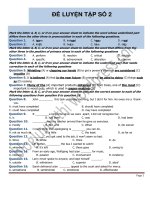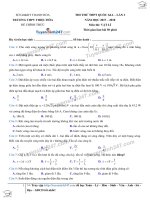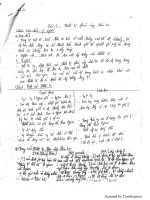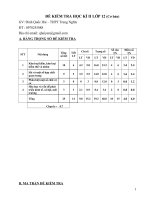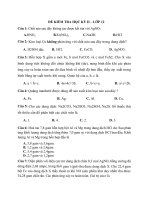Cs224W 2018 11
Bạn đang xem bản rút gọn của tài liệu. Xem và tải ngay bản đầy đủ của tài liệu tại đây (5.28 MB, 7 trang )
Stanford Memes Group: Network Construction,
Community Detection, and Link Prediction
Shelby Marcus, Yardena Hirsch
Abstract—Prior to social media, constructing and analyzing social networks relied on individual survey responses, analysis
of cellular phone logs, or email records. With the advent of social media, we have the opportunity to collect publicly available
data and construct social networks. As students at Stanford, we have the ability to collect data from a very active Facebook
group of over 28,000 members where students post memes. The group contains rich content; there are daily posts that often
receive hundreds of comments, and it is common practice for friends to tag each other in comments. We extracted the
comments from posts and constructed a graph that we hope is representative of the social network that exists offline at
Stanford. We apply motif detection, link prediction, and community detection to this graph in an effort to learn more about this
community.
Index Terms—Social Networks, Motif Detection, Community Detection, Link Prediction
1
INTRODUCTION
2
Since its emergence in November
2016, “Stanford
Memes for Edgy Trees,” commonly referred to as
Stanford Memes, has created a virtual community
stronger and better known than any other online
community on campus. With over 28,000 users
and high daily engagement, the Stanford Memes
group is a rich data source for constructing and
analyzing a social network. The Stanford Memes
group is a very active community: there are
multiple daily posts and some posts receive up
to a thousand likes and hundreds of comments
where friends tag their friends.
We construct a weighted directed graph where
nodes are users and an edge between node A and
node B signifies that user A tagged user B in a
post. It is common for a user to tag their friend
in a post that they think their friend relates to.
We will perform several analyses on this graph,
including
motif
detection,
link prediction,
and
community detection. Our goal in conducting
our network analyses is to quantify the types of
friendships observed in the graph and analyze
whether the graph we constructed accurately
depicts a social network with strong communities
and triadic closure.
RELATED
WORK
Some of our work builds off of and incorporates
findings from two papers in network analysis.
The first paper analyzes a network the authors
created from mobile communication logs, and the
second paper analyzes a social network of high
school students.
2.1
Mobile Communication
Network
In “Structure and Tie Strength in Mobile Com-
munication Networks”, Onnela et al. use mobile
phone logs to construct and analyze the structure of social networks. They found that social
networks are resilient to the removal of strong
ties but that they disintegrate with the removal
of weak ties, which stood in opposition to the
widely held belief that strong ties were responsible for maintaining network structure. We will use
their observations as guidance for the expected
structure of social networks. We will determine if
the Stanford Memes network remains intact when
removing strong ties and collapses upon the removal of weak ties. By comparing our findings to
Onnela et al.’s, we will determine if the Stanford
Memes group can be used to construct a social
network that is representative of the real life social
network.
2
2.2
High School Social Network
In “Suicide and Friendships Among American
Adolescents”, Bearman and Moody analyze
a social network of high school students to
understand
social risk factors for suicidal
ideation and suicide. The suicide rate among
adolescents has increased dramatically in recent
years. For adolescents between fifteen and
twenty four years old, suicide is the third leading
cause of death. Bearman
et al. found that, “The
friendship environment affects suicidality for
both boys and girls. Female adolescents suicidal
thoughts are significantly increased by social
isolation and friendship patterns in which friends
were not friends with each other.”
The
first factor,
estimate
confidence,
of
isolation,
decreases
self-worth
while
the
and
second
a person’s
reduces
self-
factor, intransitive
ties, leads to competing pressures from different
groups and can ultimately contribute to suicidal
thoughts and/or suicide. Suicidal ideation and
suicide are major issues on college campuses,
where twelve percent of students experience
suicidal ideation at some point in their four years
of college. As Bearman and Moody point out,
isolation is a key risk factor for suicidal thoughts
among
men
and women,
and_ intransitive
friendship patterns increase the risk of suicidal
thoughts for females. The Stanford Memes
network is an incomplete representation of the
Stanford community,
so we cannot conclude that
students who are not tagged in posts are isolated.
However,
we
will
analyze
the
transitivity
of
friendships by analyzing the prevalent motifs of
friendships for users in the network.
3
DATA COLLECTION
PROCESS
The data collection process proved more difficult
than we expected. It used to be possible to use
Facebook’s Graph API to get data from Facebook
groups. After we realized we could no longer
use Facebook’s API, we thought to crawl and
scrape the group ourselves, but the legality is
unclear and certain security measures prevented
us from doing so. We were able to find a way
to collect the data within these constraints by
downloading and parsing HTML for each post.
However, we were unable to collect all the data
we wanted to because of the amount of time it
takes to scroll and click on each post to expand
all comments. We were able to automate the
process of expanding comments for each post by
using the Google Chrome bookmarklet “Expand
All,” which saved us from having to manually
click the “View previous comments” button.
However, we were not able to find a way to avoid
manually scrolling through the page to retrieve
older posts and clicking on each post, so our data
is limited to posts from May 2018 to present.
We used the Python package BeautifulSoup
to parse the original poster name, caption,
and comments for each post, and we constructed
our network using NetworkX and SNAP libraries.
In addition to gathering data from the Facebook
group, we collected users’ majors and degree
positions from the website Stanford Who. We
used this data for detecting community structure
within the network.
4
ALGORITHMS
4.1. The Louvain
Detection
Algorithm
for
Community
We compared the Clauset-Newman-Moore algorithm with the Louvain algorithm for community
detection and found that the Louvain algorithm
performed better on our graph. The Louvain algorithm was first described by Blondel et. al in
their paper “Fast unfolding of communities in
large networks,” where they use the algorithm to
detect language communities in a Belgian phone
network of 2.6 million users. The Louvain algorithm uses a heuristic based on modularity optimization, where modularity is a measure that
compares the density of edges within and between communities, and is formally defined by
the equation that follows.
1
dịd;
1
In the first phase of the Louvain algorithm, the
algorithm greedily puts a node 7 into the community of its neighbor 7 that maximizes the change
in modularity. Instead of computing the change
in modularity by subtracting the old modularity
<<
Engineering
jee Natural Sciences
|==< Humanities
Fig. 1. Stanford Students Partitioned by Major(/eft) and Discipline(right)
from the new modularity, the Louvain algorithm
uses the equation that follows to speed up the
calculation of the change in modularity.
AQ =
4.2
Din thin
(Dtot+hi\?|
2m
2m
| Din
2m
(Ztor\?
2m
(ki
2m
\?
The ESU Algorithm for Motif Detection
In order to both
of relationships
rely on motifs,
and significant
nodes. In order
tifs, we rely on
quantify and qualify the structure
between users in the graph, we
which are defined as repetitive
patterns of connections between
to count the frequency of mothe Exact Subgraph Enumeration
(ESU) algorithm. The ESU algorithm enumerates
all subgraphs of a given size and places them into
non-isomorphic classes. We can then apply the
ESU algorithm to a randomly rewired version of
our graph, and compare the motif counts in our
original graph to the randomly rewired graph to
obtain a network significance profile. The equation for motif 2’s normalized
score, Z;, is given
below, where N(i) is the number of times motif
i appears
in the original graph and N(‘)sampiea is
the mean number of times motif i occurred over
the sampled null model.
Z, = nN
+
GEN
— —
sid(N ea)
.
Positive normalized scores indicate motifs that are
overrepresented in the original network, meaning
they occurred at a higher frequency than in the
null model. Negative normalized scores represent
motifs which are underrepresented in the original
network, meaning they occur less frequently than
they do in the randomly rewired graph. These
scores offer a metric to quantify the types of
relationships that are observed in our network.
4.3
Link Prediction via Proximity
Given a graph G at time í, the objective of link
prediction is to predict new links in G at time t+1.
We use link prediction via proximity, which computes the score of all pairs of nodes using some
scoring function, sorts these scores in descending
order, and predicts the top n pairs as new links.
We use the Adamic/ Adar scoring function, which
is calculated using:
A(x, y)
—
»
ueN(z)nN(u)
1
loglN@)|
where N(x) is the neighbors of node x.
5
5.1
RESULTS
AND ANALYSIS
Preliminary Analysis
We constructed a weighted, directed graph
where nodes are a subset of the members in the
Facebook group and an edge exists from user A
to user B if user A tags user B in a comment.
The graph contains 8,042 nodes and 10,047 edges,
and the sizes of the largest weakly and strongly
connected components are in Figure 3.
The graph has an average clustering coefficient
4
of .052. The average clustering coefficient
which might be due to incomplete data
fact that a person’s friends may be friends
life but they are not active in the group.
Figure 2 we see that the majority of users
low degree, but there are some nodes with
degrees of around ten.
Proportion of Nodes with a Given Degree (log)
Degree
103
4
102
4
101
4
Distribution
of the Stanford
Memes
is low,
or the
in real
From
have a
higher
Network
tigate
10°
10!
Node Degree (log)
Fig. 2. Degree Distribution
Nodes
8042
Edges
10047
Nodes in Largest WCC
4480
Edges in Largest WCC
7621
Nodes in Largest SCC
801
Edges in Largest SCC
2042
Average Clustering Coefficient
0.052
Fig. 3. Graph Statistics
5.2.1
School of Law, Graduate
Community Detection
Partitioning on Academic Majors
We explored whether strong community structure
exists within academic majors at Stanford. We
used the data we scraped from the website Stanford Who to partition the users into communities
based on their majors and then measured the
modularity of this partition. Figure 1 shows the
result of this partition, where each node in the
graph is a user, colors correspond to majors, and
the thickness of an edges is proportional to the
tie strength. The graph in Figure 1 is a subgraph
containing academic majors in the School of Engineering and School of Humanities and Sciences,
School of Business, or
the School of Medicine. The modularity of this
partition is 0.16, so there is not significant community structure within majors. From the plot in
Figure 1 we see that there are many edges leaving
each community. If the network we constructed
represents the Stanford community in real life,
then Stanford students have more close friends
outside of their major than within their major.
5.2.2
10° 4
5.2
but it does not contain students in the Stanford
The Louvain
and Clauset-Newman-Moore
Algorithms
We used the Louvain and Clauset-NewmanMoore algorithms to detect communities in our
network. A summary of the detection statistics
can be found in Figure 6. Visualizations of the
Louvain and Clauset-Newman-Moore detected
communities can be found in Figures 4 and 5,
respectively. These visualizations only display
communities with more than 100 members for
simplicity. Overall, the Louvain algorithm detected higher quality communities, as inferred
from its modularity. Both algorithms detected a
large number of communities with the majority
of communities having few members. It is our
understanding that users tend to tag their close
friends in comments, so it makes sense for there to
be many small communities within this network.
5.3
Link Prediction
We use link prediction via proximity with the
Adamic/Adar scoring function. We split the data
into two graphs: the first graph, Go, has edges
from posts created before time ¢ and the second
graph, G41, has edges from posts created after
time ¢t until the present. First we created the
core graph
of Go,
where
the induced
subgraph
contains only nodes with degree greater than two.
We apply the scoring function to all pairs of nodes
in the core, and we select the top n scoring pairs as
new edges. This method predicted 19 correct links
out of 1,000, so our link prediction model does not
make accurate predictions. This may be due to the
fact that people generally make new friendships
as the school year progresses and their circles of
friends cross, and we are making predictions over
a shorter period of time that doesn’t allow these
relationships enough time to develop.
Fig. 5. Community Detection using Clauset-Newman-Moore Algorithm: Non-Contracted (/eft) and Contracted Supernodes (right)
Partition
Number of C
Size of Largest C
Academic Majors
45
464
0.16
Louvain Algorithm
1375
183
0.88
\Clauset-Newman-Moore Algorithm
1397
807
0.78
Fig. 6. Community Detection Statistics
5.4
Motif Detection
We used the ESU algorithm to count all nonisomorphic directed 3-subgraphs in the original
graph and compared the counts to those found in
the randomly-rewired model. There are thirteen
non-isomorphic directed 3-subgraphs, as seen in
Figure 7. From the network significance profile
in Figure 8, we see that motifs 3, 5, 6, 7, 8, 10,
11 are overrepresented
in the graph compared
to the null model. Motif eight is the most
overrepresented subgraph, and it corresponds to
a subgraph where there are bidirectional edges
between node A and node B and between node
A and node C,, but no edge between node B and
node C’. This subgraph corresponds to a person
being close friends with two people who are not
friends with each other.
This motif is especially interesting because, as
we discussed earlier, Bearman and Moody found
in their analysis of a high school social network
that suicidal thoughts among female adolescents
are significantly increased by friendship patterns
in which friends are not friends with each other.
These intransitive friendship patterns are a risk
BoE
ATR oF
ot eee lee
Fig. 7. All Possible Non-lsomorphic Directed 3-Subgraphs
Z Scores for Stanford Memes Graph
Link Removal by Tie Strength
1.0 4
Size of Largest Connected Component
factor for suicidal ideation, which is a major issue
on college campuses. Our graph is an incomplete
representation of the real Stanford social network,
so we cannot conclude that these friendships are
truly intransitive, but this over represented motif
is an interesting aspect of our network.
—
—
Weak Ties
Strong Ties
0.8 1
0.6 4
0.4 4
0.2 4
0
1000
2000
3000
Number of Nodes Removed
4000
5000
Fig. 9. The Effects of Removing Strong and Weak Ties on Network
Robustness
involved a significant amount of manual work.
Although the graph that we constructed is large,
it does not have significantly more edges than
it does nodes. This could be due to the fact that
users only tag a small subset of there real life
400 5
300 4
Z Score
friends, or it could be due to the limited data.
100 4
2
4
6
8
10
12
Motif Index
Fig. 8. Network Significance Profile on 3-Node Motifs
6
THE EFFECTS OF STRONG AND WEAK
TIES ON NETWORK ROBUSTNESS
Onnela et al. found in their analysis of mobile
communication logs that social networks are resilient to the removal of strong ties but that they
quickly collapse upon the removal of weak ties
that connect communities. In Figure 9, we see
that removing weak ties disconnects the network
sooner than when we remove strong ties.
7
CONCLUSION
We were able to build a relatively large graph
given the fact that the data collection process
We did not find significant community structure
within majors, which may be due to limited data
or the fact that people often have friends from
diverse backgrounds and different majors. The
community detection algorithms were able to
partition the network into a set of communities
with high modularity. Further work could
be done to detect if these communities are
meaningful by collecting data about student
group involvement, dorm life, and academic year
in combination with our academic major data.
The precision of our link prediction model
was very low. We suspect that this could be
due to the time frame from which we collected
data. It is often the case that students live in
new residents, join new clubs, and try new
things at the beginning of the academic year. We
hypothesize that it is less likely for friendship to
develop from spring quarter through summer
and into the fall. We believe that using a graph
derived from data from autumn and winter
quarter would better be able to predict links
made in the spring.
We found that motif eight in Figure 7 was
significantly overrepresented in our network.
This finding is interesting because Bearman and
Moody found that intransitive ties are a risk
factor for suicidal ideation, which is an issue on
all college campuses.
8
FUTURE
WORK
Unfortunately we were not able to obtain the
complete two year history of the Stanford Memes
Group because the manual process of getting the
data was time intensive. Future work includes
getting more data and going over our analyses
again. We expect that more data would lead
to larger and stronger communities and more
accurate link prediction.
Code Repository:
https: / /github.com/yardenahirsch/cs224w_
final_project
REFERENCES
[1]
[2]
[3]
[4]
J.-P. Onnela, J. Saramaki, J. Hyvonen, G. Szabo, D. Lazer, K.
Kaski, J. Kertesz, and A.-L. Barabasi, Structure and tie strengths
in mobile communication networks, PNAS, 2007.
Peter S. Bearman and James Moody, Suicide and Friend-
ships Among American Adolescents, American Journal of Public
Health, 2004.
Leskovec, J. (2018). CS224W: Analysis of Networks, Homework 2.
Blondel, V. D., Guillaume, J.-L., Lambiotte, R. and Lefebvre, E.
(2008). Fast unfolding of communities in large networks. Journal of
Statistical Mechanics: Theory and Experiment, 2008, P10008.

